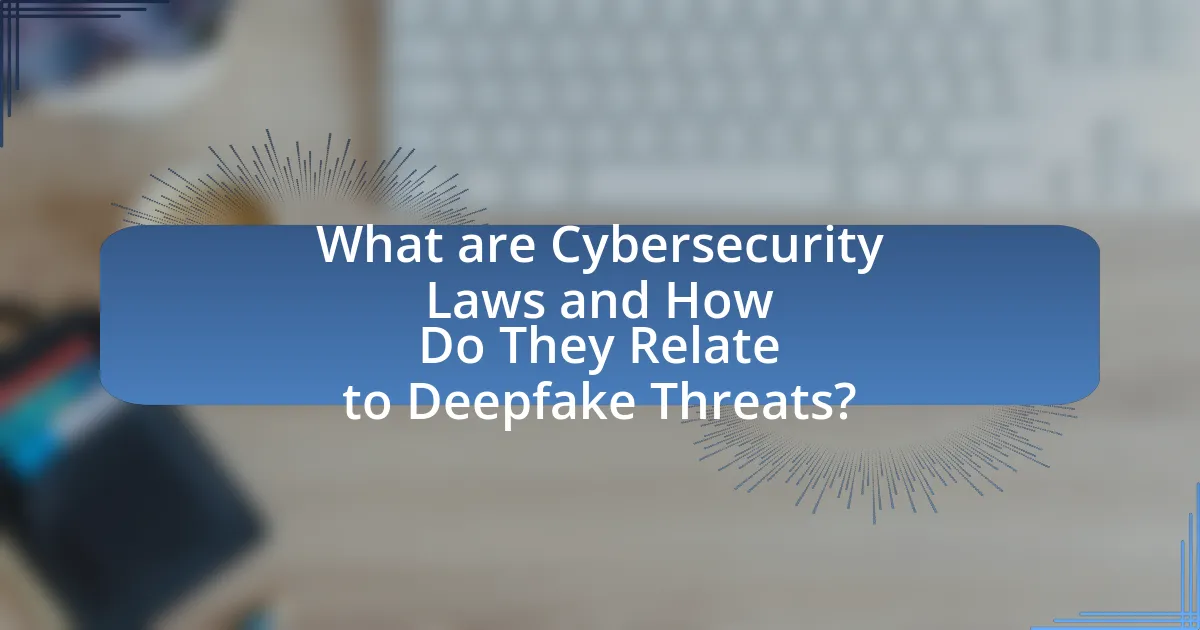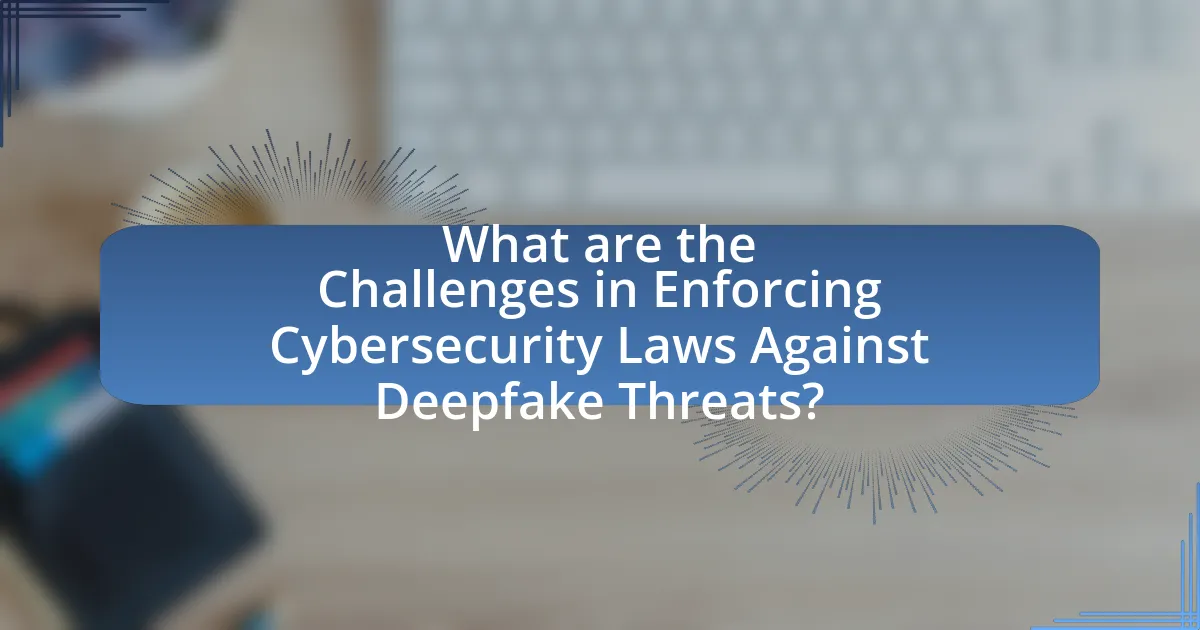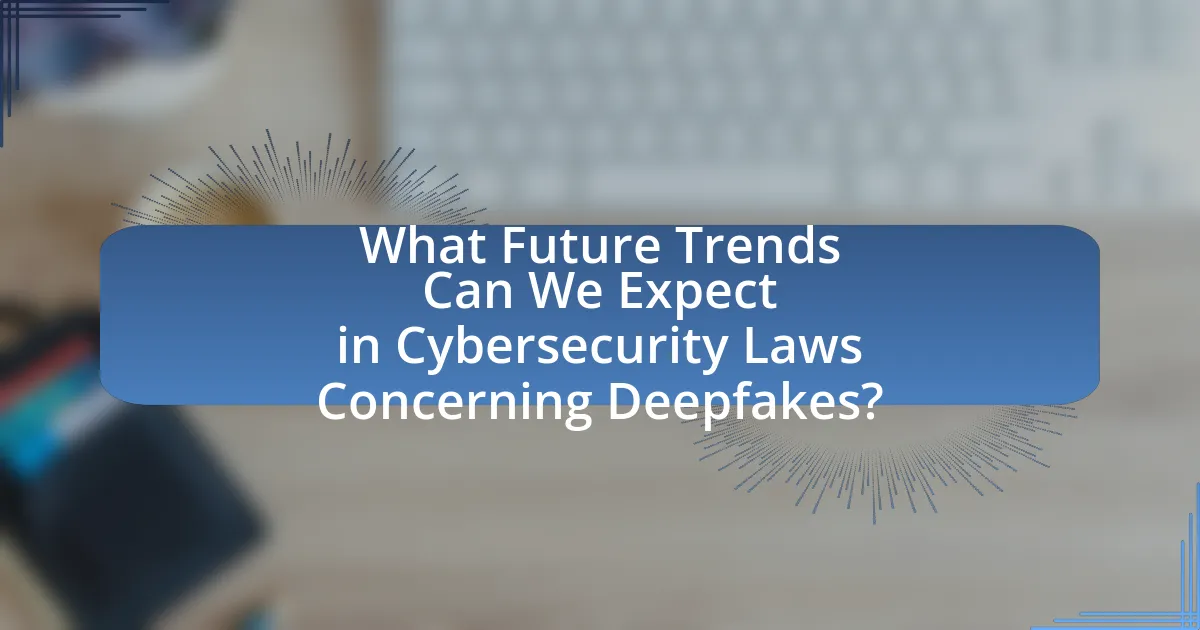The main entity of the article is the intersection of cybersecurity laws and deepfake threats. The article provides an overview of how cybersecurity laws are designed to protect against various cyber threats, including the misuse of deepfake technology, which can lead to misinformation, fraud, and reputational damage. It discusses specific legal frameworks in place, such as the Malicious Deep Fake Prohibition Act in the U.S. and the European Union’s Digital Services Act, aimed at regulating deepfakes. Additionally, the article highlights the challenges in enforcing these laws, the risks posed by deepfakes to individuals and organizations, and the proactive measures that can be taken to mitigate these risks. It concludes by examining future trends in legislation and the role of technology in combating deepfake threats.

What are Cybersecurity Laws and How Do They Relate to Deepfake Threats?
Cybersecurity laws are regulations designed to protect computer systems, networks, and data from cyber threats, including unauthorized access and data breaches. These laws relate to deepfake threats as they address the misuse of technology that creates realistic but fabricated audio and visual content, which can lead to misinformation, fraud, and reputational harm. For instance, the U.S. has enacted laws like the Malicious Deep Fake Prohibition Act, which criminalizes the use of deepfakes for malicious purposes, thereby reinforcing cybersecurity measures against such threats. Additionally, the General Data Protection Regulation (GDPR) in Europe emphasizes data protection and privacy, which can be compromised by deepfake technology, highlighting the need for robust legal frameworks to mitigate these risks.
How do cybersecurity laws address emerging technologies like deepfakes?
Cybersecurity laws address emerging technologies like deepfakes by implementing regulations that specifically target the misuse of such technologies. For instance, laws in various jurisdictions criminalize the creation and distribution of deepfakes that are intended to deceive or harm individuals, particularly in contexts like fraud, harassment, or misinformation. In the United States, the Malicious Deep Fake Prohibition Act of 2018 exemplifies this approach by making it illegal to use deepfake technology to harm others or to interfere with elections. Additionally, the European Union’s proposed Digital Services Act aims to hold platforms accountable for hosting harmful content, including deepfakes, thereby reinforcing the need for proactive measures against such technologies. These legal frameworks are designed to deter malicious use and protect individuals from the potential harms associated with deepfakes.
What specific legal frameworks are in place to combat deepfake threats?
Several specific legal frameworks are in place to combat deepfake threats, including state laws, federal legislation, and international agreements. In the United States, states like California and Texas have enacted laws targeting the malicious use of deepfakes, particularly in contexts such as election interference and non-consensual pornography. The Malicious Deep Fake Prohibition Act of 2018 proposed federal legislation aimed at criminalizing the use of deepfakes to harm individuals or deceive the public. Additionally, the National Defense Authorization Act includes provisions addressing deepfakes in the context of national security. Internationally, the European Union’s Digital Services Act aims to regulate harmful content online, which encompasses deepfakes. These frameworks collectively aim to deter the misuse of deepfake technology and protect individuals and society from its potential harms.
How do these laws vary across different jurisdictions?
Cybersecurity laws related to deepfake threats vary significantly across different jurisdictions. For instance, the United States has a patchwork of state laws addressing deepfakes, with some states like California enacting specific legislation targeting the malicious use of deepfakes, while others rely on existing fraud and defamation laws. In contrast, the European Union is working towards a comprehensive regulatory framework under the Digital Services Act, which aims to address the risks posed by deepfakes more uniformly across member states. Additionally, countries like China have implemented strict regulations on internet content, including deepfakes, emphasizing state control and censorship. These variations reflect differing legal priorities, cultural attitudes towards technology, and the perceived risks associated with deepfakes in each jurisdiction.
Why is it important to understand the intersection of cybersecurity laws and deepfakes?
Understanding the intersection of cybersecurity laws and deepfakes is crucial because it addresses the legal implications and protections against the misuse of technology that can harm individuals and society. Deepfakes can facilitate identity theft, misinformation, and defamation, which cybersecurity laws aim to regulate and mitigate. For instance, the rise of deepfake technology has prompted lawmakers to consider new regulations, as existing laws may not adequately cover the unique challenges posed by this technology. The legal framework must evolve to protect individuals from potential harm while balancing innovation and freedom of expression.
What risks do deepfakes pose to individuals and organizations?
Deepfakes pose significant risks to individuals and organizations, primarily through misinformation, reputational damage, and financial fraud. Misinformation can lead to the spread of false narratives, as deepfakes can convincingly alter video and audio content, making it appear that individuals said or did things they did not. This can result in reputational harm, as seen in cases where public figures have been targeted, leading to public backlash and loss of trust. Additionally, organizations face financial fraud risks, as deepfakes can be used to impersonate executives or employees, facilitating scams such as unauthorized fund transfers. According to a report by the Deeptrace Labs, the number of deepfake videos online increased by 84% from 2018 to 2019, highlighting the growing prevalence of this technology and its associated risks.
How can cybersecurity laws mitigate these risks?
Cybersecurity laws can mitigate risks associated with deepfake threats by establishing legal frameworks that define and penalize the creation and distribution of malicious deepfakes. These laws can deter potential offenders by imposing significant penalties, thereby reducing the prevalence of harmful deepfake content. For instance, California’s AB 730 law specifically targets the use of deepfakes for malicious purposes, such as defamation or fraud, and provides a legal recourse for victims. Additionally, cybersecurity laws can mandate transparency and accountability for platforms hosting user-generated content, requiring them to implement measures that detect and remove deepfake material. This proactive approach not only protects individuals but also fosters a safer digital environment, as evidenced by the increasing number of jurisdictions adopting similar regulations to combat the misuse of deepfake technology.

What are the Challenges in Enforcing Cybersecurity Laws Against Deepfake Threats?
Enforcing cybersecurity laws against deepfake threats faces significant challenges due to the rapid evolution of technology and the difficulty in identifying the creators of deepfakes. The anonymity provided by the internet allows malicious actors to produce and distribute deepfakes without accountability, complicating legal action. Additionally, existing laws often lack specific provisions addressing the unique characteristics of deepfakes, leading to gaps in legal frameworks. For instance, the U.S. does not have comprehensive federal legislation specifically targeting deepfakes, which hinders consistent enforcement across states. Furthermore, the technical expertise required to analyze and verify deepfakes often exceeds the capabilities of law enforcement agencies, making it difficult to gather evidence for prosecution. These factors collectively impede effective enforcement of cybersecurity laws against the growing threat of deepfakes.
What obstacles do law enforcement agencies face in tackling deepfake-related crimes?
Law enforcement agencies face significant obstacles in tackling deepfake-related crimes, primarily due to the rapid advancement of technology and the sophistication of deepfake creation tools. These agencies struggle with the lack of clear legal frameworks specifically addressing deepfakes, which complicates the prosecution of offenders. Additionally, the anonymity provided by the internet allows perpetrators to evade detection, making it challenging for law enforcement to trace the origins of deepfake content. A report from the European Commission highlights that 70% of law enforcement officials believe that current laws are insufficient to address the complexities of digital misinformation, including deepfakes. Furthermore, the technical expertise required to analyze and identify deepfakes is often lacking within law enforcement, leading to difficulties in gathering evidence and building cases against offenders.
How does the rapid evolution of technology complicate legal enforcement?
The rapid evolution of technology complicates legal enforcement by outpacing existing laws and regulations, making it difficult for legal systems to address new forms of crime effectively. For instance, the rise of deepfake technology has created challenges in identifying and prosecuting fraudulent activities, as traditional legal frameworks often lack specific provisions for digital impersonation or manipulation. According to a report by the Brookings Institution, the increasing sophistication of deepfakes can undermine trust in digital content, complicating the enforcement of laws related to fraud and defamation. This gap between technological advancement and legal adaptation leads to enforcement difficulties, as law enforcement agencies struggle to keep up with the tools and tactics employed by cybercriminals.
What role do international laws play in addressing cross-border deepfake issues?
International laws play a crucial role in addressing cross-border deepfake issues by establishing a framework for cooperation among nations to combat the misuse of this technology. These laws facilitate the prosecution of individuals and entities that create or distribute harmful deepfakes across borders, ensuring that victims have legal recourse regardless of where the deepfake originated. For instance, treaties like the Budapest Convention on Cybercrime provide guidelines for international collaboration in investigating and prosecuting cybercrimes, including those involving deepfakes. Additionally, international human rights laws protect individuals from defamation and privacy violations that can arise from malicious deepfake content, reinforcing the need for countries to align their domestic laws with international standards to effectively tackle these challenges.
How can organizations protect themselves from deepfake threats under current laws?
Organizations can protect themselves from deepfake threats under current laws by implementing robust verification processes and utilizing technology to detect manipulated media. These measures include training employees to recognize deepfakes, employing AI-based detection tools, and establishing clear protocols for verifying the authenticity of digital content. Current laws, such as the Defend Against Cyber Threats Act, provide a framework for organizations to report and respond to deepfake incidents, thereby enhancing their legal protection and compliance. Additionally, organizations can leverage intellectual property laws to safeguard their brand and reputation against malicious deepfake usage.
What best practices should organizations implement to comply with cybersecurity laws?
Organizations should implement a comprehensive cybersecurity framework to comply with cybersecurity laws. This includes conducting regular risk assessments to identify vulnerabilities, ensuring data encryption to protect sensitive information, and establishing incident response plans to address breaches effectively. Additionally, organizations must provide ongoing cybersecurity training for employees to foster awareness and adherence to legal requirements. Compliance with regulations such as the General Data Protection Regulation (GDPR) and the Health Insurance Portability and Accountability Act (HIPAA) further necessitates maintaining accurate records of data processing activities and ensuring third-party vendors also comply with relevant laws. These practices are essential for mitigating risks and demonstrating compliance with evolving cybersecurity legislation.
How can organizations educate their employees about deepfake risks?
Organizations can educate their employees about deepfake risks through comprehensive training programs that include awareness sessions, practical demonstrations, and regular updates on emerging threats. These programs should cover the definition of deepfakes, their potential impact on security and reputation, and methods for identifying and reporting suspicious content. Research indicates that 70% of employees feel more confident in their ability to recognize deepfakes after participating in targeted training (Source: Cybersecurity & Infrastructure Security Agency, 2021). By implementing these educational strategies, organizations can significantly enhance their workforce’s ability to mitigate the risks associated with deepfakes.

What Future Trends Can We Expect in Cybersecurity Laws Concerning Deepfakes?
Future trends in cybersecurity laws concerning deepfakes will likely focus on stricter regulations and enhanced accountability for creators and distributors of deepfake technology. As deepfakes pose significant risks to privacy, misinformation, and security, lawmakers are increasingly recognizing the need for comprehensive legal frameworks. For instance, jurisdictions like California have already enacted laws targeting the malicious use of deepfakes, indicating a trend toward more robust legal measures. Additionally, international cooperation may increase as deepfake technology transcends borders, leading to harmonized regulations that address the global nature of the threat. This evolution in cybersecurity laws will be driven by the growing prevalence of deepfakes in various sectors, including politics and entertainment, necessitating proactive legal responses to mitigate potential harms.
How are lawmakers adapting to the challenges posed by deepfakes?
Lawmakers are adapting to the challenges posed by deepfakes by implementing new legislation aimed at regulating the creation and distribution of such content. For instance, several states in the U.S. have enacted laws that specifically criminalize the malicious use of deepfakes, particularly in contexts like election interference and non-consensual pornography. These laws often include penalties for individuals who create or disseminate deepfakes with the intent to harm or deceive others. Additionally, lawmakers are collaborating with technology experts to develop tools that can detect deepfakes, thereby enhancing public awareness and safety. This proactive approach is essential as deepfakes pose significant risks to misinformation and personal privacy, necessitating a legal framework that can effectively address these emerging threats.
What new legislation is being proposed to address deepfake threats?
New legislation proposed to address deepfake threats includes the Deepfake Accountability Act, which aims to criminalize the malicious use of deepfakes for fraud, harassment, or misinformation. This act seeks to establish clear legal definitions and penalties for the creation and distribution of harmful deepfake content, thereby enhancing accountability. The proposal is supported by growing concerns over the potential for deepfakes to undermine trust in media and facilitate criminal activities, as evidenced by numerous incidents where deepfakes have been used to manipulate public opinion or defraud individuals.
How might technological advancements influence future cybersecurity laws?
Technological advancements will likely lead to more stringent cybersecurity laws to address emerging threats. As technologies such as artificial intelligence and deepfake capabilities evolve, they create new vulnerabilities and methods for cybercrime, necessitating legal frameworks that can adapt to these changes. For instance, the rise of deepfake technology has already prompted discussions around the need for laws that specifically target misinformation and identity theft, as evidenced by legislative proposals in various jurisdictions aimed at regulating the use of synthetic media. These advancements will push lawmakers to create proactive measures that not only penalize cybercriminals but also establish standards for technology developers to ensure ethical use and security.
What proactive measures can individuals and organizations take to stay ahead of deepfake threats?
Individuals and organizations can stay ahead of deepfake threats by implementing advanced detection technologies and fostering digital literacy. Advanced detection technologies, such as AI-based tools, can analyze video and audio content for inconsistencies that indicate manipulation. For instance, companies like Deeptrace and Sensity AI provide solutions that identify deepfake content with high accuracy. Additionally, fostering digital literacy among employees and the public can help individuals recognize and critically evaluate suspicious media. Research from the Stanford History Education Group shows that teaching critical media consumption skills significantly improves the ability to discern misinformation. By combining these proactive measures, individuals and organizations can effectively mitigate the risks posed by deepfakes.
What tools and technologies are available to detect and combat deepfakes?
Tools and technologies available to detect and combat deepfakes include machine learning algorithms, digital forensics techniques, and specialized software solutions. Machine learning algorithms, such as convolutional neural networks, analyze video and audio data to identify inconsistencies that indicate manipulation. Digital forensics techniques involve examining metadata and pixel-level anomalies to uncover alterations. Specialized software solutions, like Deepware Scanner and Sensity AI, provide real-time detection capabilities and threat intelligence to identify deepfake content. These tools leverage advancements in artificial intelligence and data analysis to enhance accuracy and effectiveness in combating deepfake threats.
How can individuals advocate for stronger cybersecurity laws related to deepfakes?
Individuals can advocate for stronger cybersecurity laws related to deepfakes by engaging in grassroots campaigns, contacting legislators, and raising public awareness. Grassroots campaigns can mobilize community support, while direct communication with lawmakers can emphasize the urgency of addressing deepfake threats, as evidenced by the increasing prevalence of deepfake technology in misinformation and identity theft cases. Public awareness initiatives, such as educational workshops and social media campaigns, can inform citizens about the risks associated with deepfakes, thereby creating a demand for legislative action. According to a report by the Brookings Institution, deepfakes pose significant risks to privacy and security, highlighting the need for comprehensive legal frameworks to mitigate these threats.


